Choosing the right monetization model is especially crucial when it comes to a VOD business – and it’s not an easy task.
It’s actually one of the most common questions creators ask: “What’s the best way to charge people for access to my on-demand content?
Which leads to the second most asked question, “… And how much should I charge them?”
The reason why it’s so hard to decide this is because, unlike with any physical product, the typical “cost-plus pricing model” doesn’t apply to an online video business.
So in this guide, we’re going to break down the 3 main ways you can sell your video content, and explain how to figure out the perfect price to charge your viewers.
What is SVOD?
SVOD, or Subscription Video on Demand, is a monetization model where people pay a subscription fee to access a library of films, TV shows, and other content. The fee is usually monthly, but many SVOD services also offer annual billing.
How it works
SVOD services are huge in the streaming industry. You’re already using an SVOD platform if you like to binge TV shows on Netflix or Hulu. Once someone subscribes to a service, they have unlimited access to the platform’s content library.
Some SVOD platforms will be ad-free, but others will include ads on lower-tier pricing packages. Regardless, you’ll find a mix of original productions and licensed content on many SVOD platforms. Today, creators can create their own SVOD service and sell videos online with platforms like Uscreen.
Popular SVOD platforms
SVOD examples you may know of include:
- Netflix
- Amazon Prime Video
- Disney+
- Hulu
- HBO Max
SVOD pros
The SVOD model has plenty of benefits for subscribers. It allows viewers to watch what they want, when they want, without being tied to a network’s broadcasting schedule.
Say you want to learn ballet and tap dancing, you can sign up for a monthly subscription to BDC Online and learn on your own schedule. You can also stream the videos through your phone, tablet, smart TV, or computer with the BDC online OTT app.

For content creators, SVOD offers a world of benefits for growing your video business. You can:
- Have a reliable income since viewers pay a recurring fee.
- Reach a broad audience by meeting different viewing preferences.
- Offer subscribers direct access to exclusive content.
- Have full creative freedom since you distribute your own content.
- Build a community around your brand.
Sounds fantastic, doesn’t it? That’s why some 83% of US consumers use a subscription video-on-demand service, and the market generates over $30 billion per year. Creators can easily boost SVOD revenue with an OTT platform and grow their video business.
SVOD cons
SVOD does come with some disadvantages. Even though audiences pay a recurring fee, these subscribers have the flexibility to cancel at any time, which means you have to work a bit harder to keep them around. For creators, you have to keep releasing new content to keep them interested.
Some other cons of SVOD include:
- Investing more time and money in higher quality content.
- Having to maintain quick and efficient customer service.
- Keeping up with platform price changes.
That’s not all too bad when you think about it. Any business you run will need high quality content and service to attract and retain customers. It’s just more prominent with the SVOD model because people are paying every month (or year) for your service.
Ads and one-off purchases require less maintenance but earn you less money.
Build, launch and manage your membership, all in one place.
What is AVOD?
AVOD, or advertising video-on-demand, is another popular way to monetize video that’s free for viewers and makes money from ads. Ads are typically shorter, between 15 and 30 seconds, and can run before, during, or after a video.
How it works
This type of service refers to advertisement-based video on demand that is free to its consumers. Here, ad revenue is used to offset production and hosting costs.
And ad-supported content is everywhere. You take part in it when you tune into your favorite YouTube channel to watch those cute kitty compilations!
All of that kitty content is free because most of the time you’ll see ads through the videos, which is the one way YouTube creators monetize their videos. Beyond YouTube, AVOD is now the backbone of many streaming platforms that host a variety of free on-demand content.
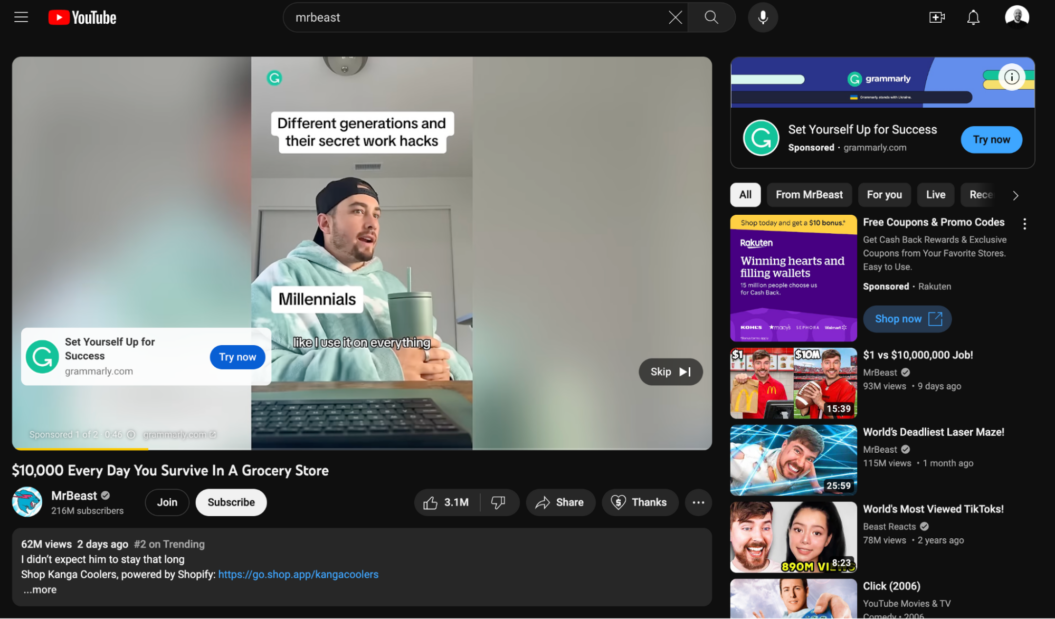
So, if you, as a content creator, want to host content for free on an AVOD platform, you’ll be running ads on your content in order to generate revenue.
Popular AVOD platforms
Popular AVOD platforms you might know are:
- YouTube
- Tubi
- Pluto TV
- Roku Channel
- Crackle
AVOD pros
AVOD is attractive for viewers because they can watch free content, plain and simple. For creators, AVOD is a low risk way to earn income from your videos without selling anything. People simply come to your channel, watch a video and an ad, and you get paid.
Other advantages of AVOD include:
- Access to a broad audience through platforms like YouTube.
- Good revenue potential with a large enough audience.
- Lower barrier to entry because viewers don’t need to make a financial commitment.
AVOD cons
The main source of income for AVOD creators is advertising, which can be unreliable at times. Take YouTube, for instance. Many creators are seeing their ad revenue decrease there.
That’s because with AVOD you might face:
- Getting denied for ad revenue programs through certain platforms.
- Content demonetization since platforms or brands might flag your content as unsuitable for ad revenue.
- Almost every platform takes a part of your ad revenue.
- Your content may be blocked by ad blockers, so you lose money.
Your revenue from the platform will also depend on your audience’s location, since there are areas with lower CPMs that could make you even less money in the end. All this is to say that AVOD can be unpredictable and unreliable.
What is TVOD?
TVOD, or transactional video-on-demand, is based on a pay-per-view system, so viewers can purchase content they choose to watch on a one-time basis.
How it works
Transactional-based video on demand is the opposite of SVOD, in the sense that you are charged per video or video package rather than gain access to the entire catalog. Viewers can browse a catalog to find a video they want to watch, then rent it for limited-time access, or buy it for permanent access.
For example, Magic Stream, a brand that uses Uscreen, lets viewers buy one video or sign up for a membership on the same checkout page.
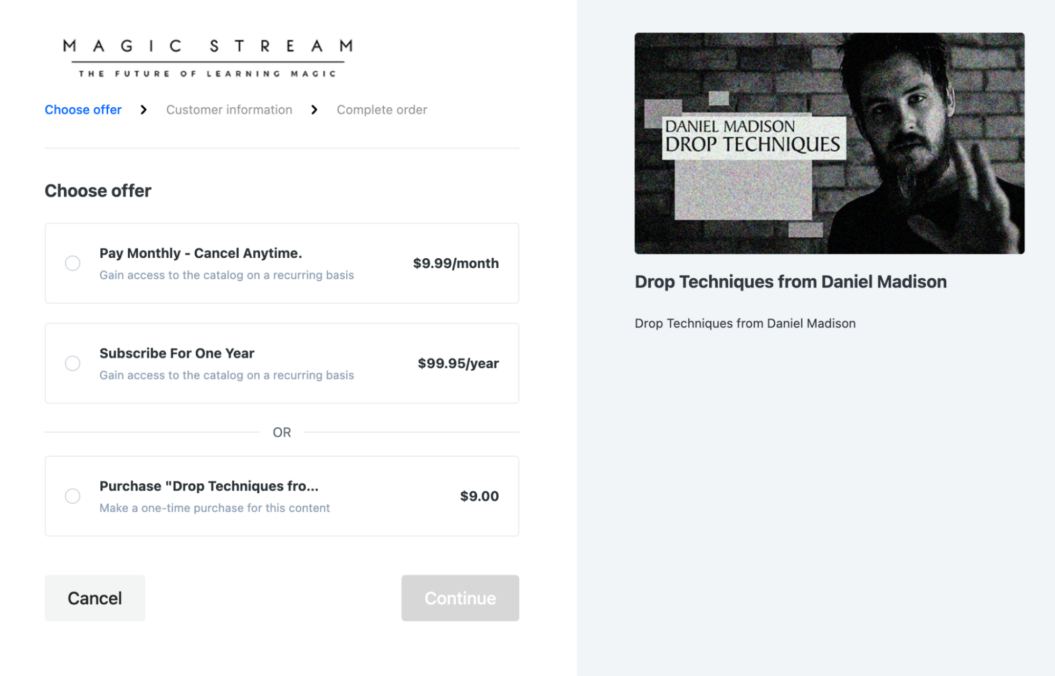
Popular TVOD platforms
Some popular TVOD platforms you’ll know are:
- Apple iTunes
- Google Play
- Vudu
- YouTube Movies
TVOD pros
One of the main benefits of the TVOD services model is that it caters to customers who only want to pay for the piece of content they will watch.
With TVOD, you can:
- Easily bring more value, since each piece of content has its own price.
- Provide less expensive content since you don’t have to charge more for a subscription.
- Price your content more competitively.
- Give your customers the option to keep your video forever.
Plus, this transactional video monetization model is a great way to host one-time paid events such as a concert live stream or a game match.
TVOD cons
You guessed it — TVOD also comes with some disadvantages.
Since the model is on a pay-per-view basis, it makes TVOD services feel more “disposable”. This means that:
- Typically, people will only use your service when they need something, and then they’re done.
- As they’ll only go to your platform to find exactly what they need, they’ll likely miss unique content, promotions, and offerings.
- You’ll miss out on creating a loyal community.
The big downside: If you want to release a lot of content, you’ll have to price each piece separately, which takes time to get right.
What is HVOD?
HVOD, or Hybrid Video on Demand, combines all the above approaches to VOD services. You can monetize content through a mix of SVOD, AVOD, or TVOD and diversify your revenue stream.
How it works
If you’re looking for the best way to release your content and start making money as a content creator, you could combine these monetization models. Yes, it’s true: you can offer your audience both a subscription fee option (SVOD) and let them pay a one-time fee for certain content (TVOD), all while releasing free content with ads (AVOD).
Take Fader Pro as an example. They charge a subscription fee to access their content, however, they also have exclusive content that you can pay a one-time fee to access, like mentoring or premium lessons.
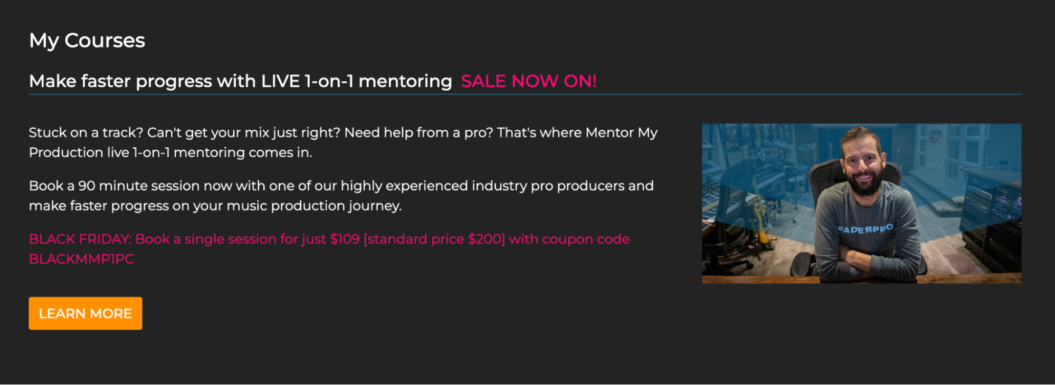
Or you can combine AVOD and SVOD, just like Peacock (and just about every other SVOD service now) does. They allow you to watch content with ads for a low price, but if you want to unlock all of their content, you can pay a higher subscription fee.
But is HVOD worth it? Combining these methods will allow you to target different audiences and demographics, but could take more work and effort in the long run.
Popular HVOD platforms
Many SVOD platforms have turned into HVOD platforms these days. Some common examples include:
- Amazon Prime Video (SVOD and TVOD)
- Hulu (SVOD and AVOD)
- YouTube (AVOD, SVOD, and TVOD)
- Apple TV (SVOD and TVOD)
HVOD pros
HVOD offers flexibility and can be lucrative, as it caters to diverse viewer preferences. Some advantages for creators include:
- Tapping into multiple revenue sources.
- Reaching a wider audience of free and paid viewers.
HVOD cons
On the other hand, it can be hard to manage so many platforms at once. That’s why finding the right VOD platform is key, since some will offer all of these options in one place.
Some drawbacks of HVOD include:
- Viewers may not like intrusive ads, especially after paying a subscription fee.
- Some desirable content may be locked behind different payment models, which is frustrating to navigate viewers.
👉 Want to start a streaming service? Learn how to get started with Uscreen.
AVOD vs. SVOD vs TVOD: What makes each unique?
Now that you know how all these models work, let’s quickly look at how they compare so you can choose one:
| Model | Payments | Customer experience | Revenue |
| SVOD | Subscription fees | Convenient, no-ads | High |
| AVOD | Ad revenue | Free access with ad interruptions | Low |
| TVOD | One-time purchases | Pay only for desired content | Mid-range |
Why is SVOD popular?
Netflix has long been the leader in SVOD services globally up until 2021. More brands and creators have joined the race to capture the $159.90 billion global VOD market. SVOD is so popular because people want high-quality, original content they can watch whenever.
A recent survey found that the top 2 out of 3 reasons US consumers keep using an SVOD service was a large variety of content (61%) and high quality content (48%). With the recent rise in subscription fees across major platforms, cost has also become a factor in keeping an SVOD service.
But SVOD isn’t just the realm of giant media companies like Amazon, Netflix or Hulu. Small online business owners are using this video subscription model to grow their income, and their audience, every single day.
Over 70% of Uscreen clients have adopted an SVOD model for their video business, each of whom generates an average of $5,800 a month. We’ve also seen the impact of membership apps on revenue growth.
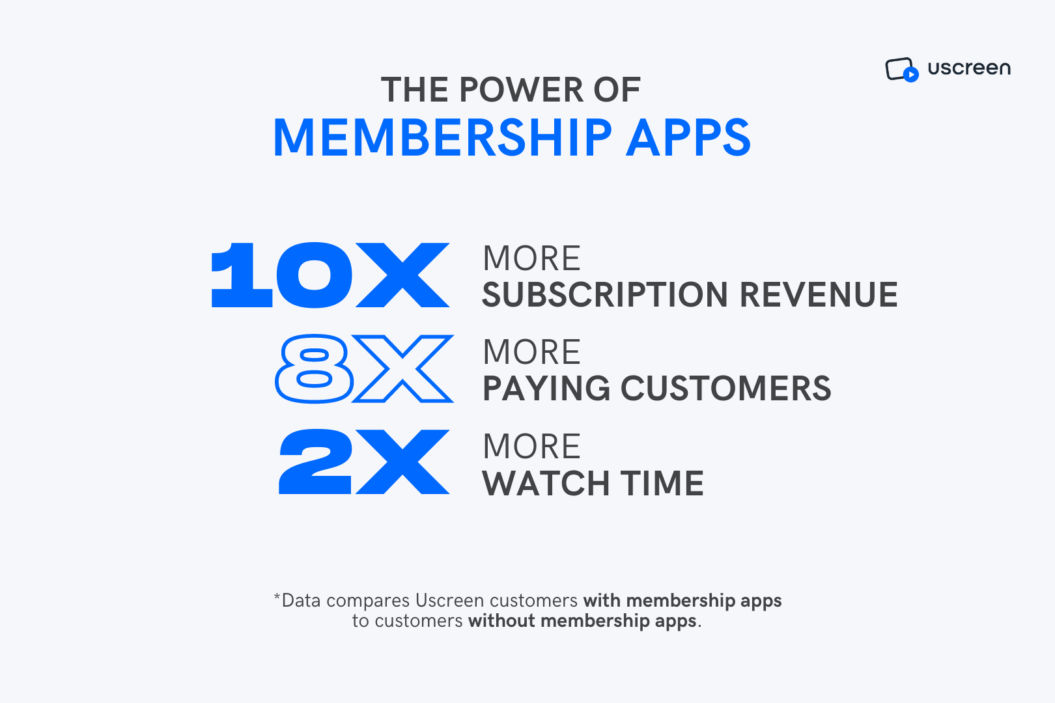
Why does SVOD work so well? Because of something called The Membership Economy.
The Membership Economy is a book by Robbie Kellman Baxter, who was a Silicon Valley product marketer and later a consultant to companies ranging from venture-backed startups to SurveyMonkey, Netflix, and Yahoo!.
The membership economy, she explains, is all about finding your super-users, establishing and growing the ‘forever’ transaction, and building recurring revenue off of something you created once – the possibilities are infinite!
So: would you rather have a subscriber pay $10 for one video once, or $10 a month for unlimited access to your entire library for years?
While we at Uscreen still do give our clients the freedom to set up either an SVOD or a TVOD (or a combination of both), we’ve seen over and over again that subscription is the most profitable way to go.
The really cool part is that this type of SVOD service doesn’t just benefit the VOD business owner – it also comes with massive benefits to the paying audience.
They can view across multiple devices for no extra fees. And a yearly subscription comes in, on average, much cheaper than a satellite or cable TV package.
How to price your SVOD service
It’s hard to price video content as a subscription because it goes against the way we’ve always priced products. By adding all your direct material, labor and overhead costs to a product or service, you can reach the perfect price for the product or service.
But, because the business models are so different, pricing an SVOD service is a bit more complicated.
A monthly VOD subscription costs on average between $7.99 and $9.99 per month, but every business is different, that’s why you want to think this over to make sure this price is right for both your business and your customers.
Our team has studied our customers’ pricing and developed an easy formula to give you a starting point. Use the calculator and tutorial below to figure out your pricing.
0
$0
1. Add up your existing follower count
How big is your current audience? How many followers do you have on social media? How many emails do you have on your list? For this formula, either use the total number of followers from each individual platform, or the main platform you’re active on.
Your existing audience, the ones you’re currently not monetizing, is the main pond you’re going to try to fish in. They’re your biggest supporters, the ones who already know your credibility in your field.
2. Find your average conversion rates
Conversion rates are the percentage of people who will arrive at your website and buy into whatever it is you’re selling. These rates differ from business to business, content type to content type, even social media platform to social media platform.
But to make it simple for our purposes, let’s consider the average range of 2-5% conversion. Use the scale in the calculator to pick the conversion rate you want to pretend you’re at.
Word of advice: if this is your first time monetizing your followers, aim low in the pricing formula (then pick 5% just to see what that would be like to be a baller!).
Set the elements of your equation and put it in the calculator. Play around with the numbers until everything makes sense.
Wait, you’re not done yet.
Keep in mind – this formula is just somewhere to get you started. We’ve found that our most successful customers offer monthly subscription prices anywhere from $2 to $50 – that’s a pretty wide window!
There are so many different factors that place these subscriptions where they’re at right now – more than a calculator can tell you. Luckily, we know what these factors are.
3. Figure out your number of paying VOD subscribers
This variable is simply the number of subscribers you would have based on the assumed conversion rate percentage of the existing followers you have.
Whatever our magic pricing calculator yields, take it and apply the following factors to it to see if your price should be higher, lower or exactly what the calculator tells you.
💡 Remember: Just because you charge less for your content, doesn’t mean you’ll make less. Some premium content is valued at a higher price per person but attracts the attention of a few. Other content is valued at much lower but is relevant to a broader audience.
All you need to do is find the perfect middle ground that suits your content type and audience, and that will get you to your revenue goal.
4. Do market research
The nature of your content will really impact how you price your content.
The best place to start here is doing your basic market research to see what competing streaming services charges their customers. If you’re going to charge higher than your biggest direct competitor, you have to be sure your service is well worth the difference and that the added value is reflecting in your brand.
The next thing to take into consideration is your content’s type and genre. From what we’ve seen, each type of content has an industry price average that you should consider and possibly abide by unless you offer content that’s very obviously more valuable and worth the difference in cost:
- Entertainment: Usually runs the lowest between $4.99 and $6.99 per month. You’re up against big giants in the streaming landscape, like Netflix and Hulu, which release new and popular entertainment regularly. But you can still offer content they don’t to compete with them at low prices.
- Health and fitness: Fitness instructors can charge viewers for their streaming content anywhere between $9.99 and $14.99 comfortably.
- Instructional, informational, and inspirational content: Think outside of fitness, like dancing or art classes. These subscriptions can range from $9.99 to $50 per month. The more niche the content, the higher you can charge.
The above numbers are just rough estimates based on what we’ve seen. If you want more accurate pricing data, it’s a good idea to ask your audience what they’d be willing to pay for your service.
Design a simple survey and include questions about budget, services they value most, and what they pay for similar services. You could even run an anonymous poll on social media to gather the same information.
If you have a group of loyal followers, you could message them or meet them on Zoom to ask for their input. It’d be a great way to make them feel valued and part of your process.
Once you have gathered the data, analyze it to find a price point that most of your followers are comfortable with and aligns with the value of your service.
5. Choose your pricing model
There are a few revenue models to choose from when pricing your SVOD streaming service. Our customers have experimented with all of them and eventually stuck to 1 of 3 of the following:
- Paywalled (with a free trial)
A free trial gives viewers access to your entire video library for free for a limited time (typically 14-30 days). Most users who try your VOD will sign up once they see how great it is.
Our research shows that this is the most lucrative pricing model among all types of subscription businesses. According to our analysis of Uscreen creators, 52% convert into paying monthly subscribers after a free trial so they can watch as much content as they like.
In addition, creators that offer free trials make on average 195% more a month than those that don’t.
- Freemium
Freemium is a basic, stripped-down version of your VOD that users can access for free. It usually drives large numbers of users, but conversion rates tend to be lower than the free trial strategy–around 3 to 5%.
Freemium, however, requires you to constantly highlight the value of premium products and make sure the user knows about them to convince them to upgrade.
- The varied access model
The varied access model is the least used in VOD. It provides different levels of content access for subscribers based on their plan.
This could be applied in any way you want – offer a particular number of views or downloads each month, access to a particular number of books or television episodes, or limit the data associated with a user based on their subscription plan.
👉 NOTE: Pricing your video content will always be a work-in-progress. We really don’t think you’ll ever be “done” with it. The market will constantly change and as your business grows, so will your audience and content. Be flexible and always test your pricing and marketing. You’ll get to know your customers more and more as time goes by, and you’ll know their content consumption and spending habits like the back of your hand.
What VOD model works best for you?
There are a few VOD models to choose from, but picking the best model for you will depend on several factors:
- The kind of content you create: Is it exclusive video on demand content that people would pay for? Can you create enough content to charge for a subscription?
- Your target audience: What are their watching habits? Do they prefer free content or paying a one-time fee?
- Your preferred platform: Do you already have a VOD platform? Do you prefer a simple-to-use platform or one with more bells and whistles?
- Your business goals: Do you want to build a tight-knit community? How much revenue do you want to generate?
By evaluating and answering these questions, you’ll be able to decide on the best business models for your brand. You can find out more about what your current audience likes by asking and engaging with them.
In short:
- If you’re looking to build a sense of community with your customers and you know they would pay a subscription fee, you could try the SVOD model.
- If your audience prefers to watch more exclusive content and they want to pay only for what they watch, then go for TVOD.
- If you know your audience already loves watching your free content and you want a platform that is simple to use, then AVOD is probably best for you.
Here’s a checklist to help you go more in-depth if you need.
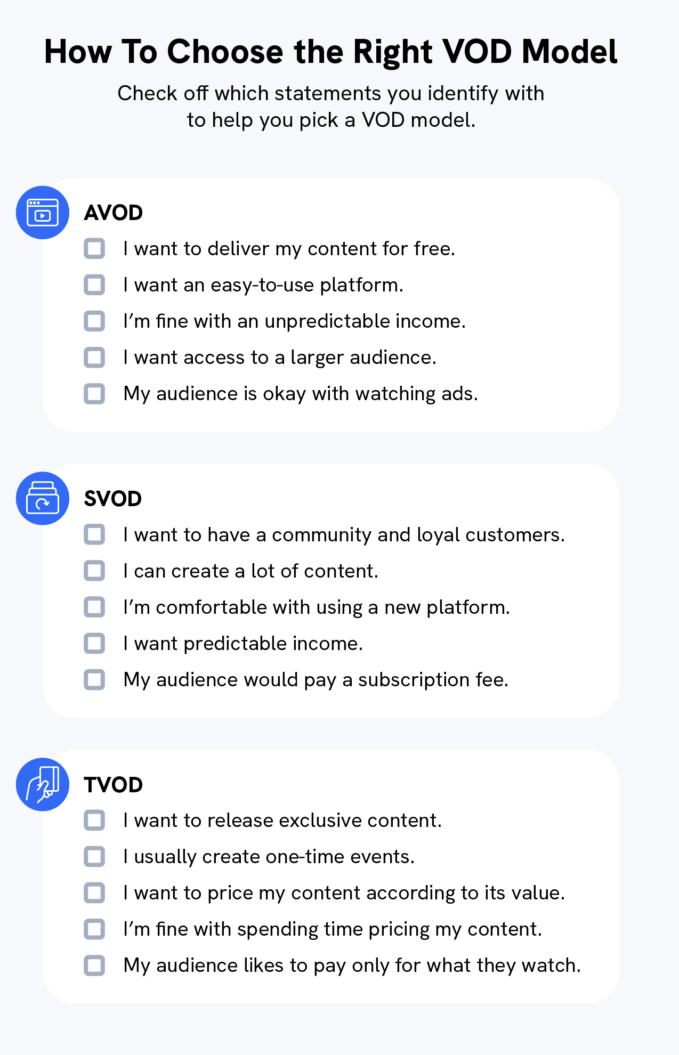
Build, launch and manage your membership, all in one place.
AVOD vs SVOD vs TVOD FAQ
Netflix originally was an SVOD platform. However, Netflix recently released an ad-supported plan that now makes it a hybrid platform.
AVOD stands for Advertising-based Video On Demand. It refers to a video monetization model where viewers can watch for free, but are shown advertisements.
AVOD (Advertising-based Video On Demand) provides free content with ads, SVOD (Subscription Video On Demand) offers content for a fee without ads, while OTT (Over The Top) refers to streaming content over the internet.







